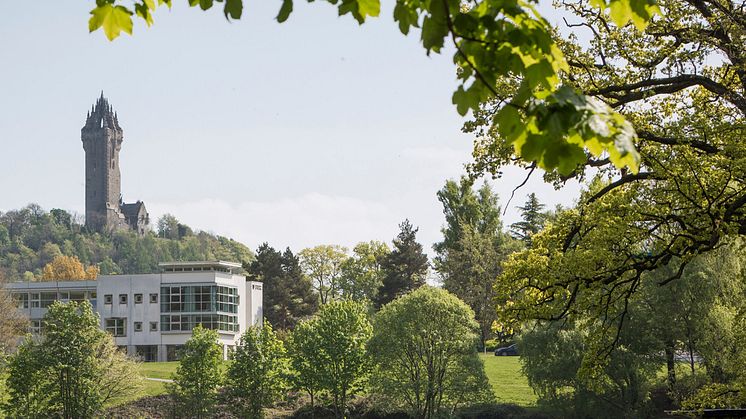
Press release -
Insurance claims response case study: University of Stirling
When heavy rain fell across Scotland on 24th June 2019, flash flooding resulted in extensive damage and travel chaos. Among those who suffered the worst of this ‘weather bomb’ was The University of Stirling.
Although the University isn’t in a flood risk area, it received half a month’s worth of rain in just three hours. Colin McNally, executive director of estates at the University of Stirling, says that when he arrived on-site at 8pm that evening, he knew it was going to be bad. “I could hear water gurgling all around me,” he explains. “We sent teams off across the campus to assess the extent of the damage but we didn’t really get a full picture of it until 2am.”
Water damage
In total, 14 buildings were affected, with water coming through roofs, under doors and up pipes and drains causing widespread damage. “Around a fifth of the estate was affected, including a third of the teaching rooms. We also had to relocate some of the students as their bedrooms had suffered so much water damage,” says McNally. “To make matters worse, we were less than 12 hours away from running the first of five graduation ceremonies and installing our new Chancellor, Lord McConnell. We had thousands of guests coming from all over the world.”
A major clean-up operation was undertaken to enable the ceremonies to take place, with buildings that weren’t underwater being converted into temporary halls and robing areas. “Our cleaning team did a fantastic job,” says McNally. “We were able to lock up the badly affected areas and focus on graduation.”
Insurance response
While this enabled all of the ceremonies to take place, it was only the beginning of the work that would be needed to return the University to its former state. When they arrived at work on 25th June, the University’s finance team contacted their broker, Gallagher, who notified Allianz of the claim.
Representatives from Allianz, Gallagher and the loss adjusters Sedgwick were on-site the following day to assess the damage. Karen Parsons, property technical claims manager at Allianz Insurance, was shocked by the extent of the damage. “We’d initially been told at least four buildings were affected but then we found out it was actually 14 buildings, of which 10 were severely damaged,” she says. “It can take at least a year to reinstate a badly damaged building and we were looking at 10 of them.”
As well as the scale of the damage, its nature took everyone aback. David Gear, major loss regional manager at Sedgwick, was one of the first onsite. “Across the campus there was no discernible pattern of damage,” he explains. “One building would be under water, the next would have suffered water damage as a result of burst pipes or a ceiling coming in. It was a diverse and highly technical claim.”
Given the scale of the work required, there was one positive. As the flooding had occurred at the end of the academic year, there wouldn’t be any students around until term started in September. With a deadline for the first phase of work set for the 5th September, this gave around nine weeks to get the university ready for the next year’s undergraduates.
Collaborative approach
To ensure this time was used as productively as possible, all the stakeholders got together to prioritise what was needed. “We knew it would be impossible to finish everything before term started again but, for us to start the new academic year, it was essential to have the teaching rooms reinstated by September to provide an excellent student experience” says McNally.
Also making the cut for this first phase of work were the computer facilities and the student accommodation. Liability was approved in eight days and Allianz made an early interim payment of £2m to cover the first phase of work.
With a list of priorities, the worst affected areas were identified at an early stage. Iain Binning, loss controller at Gallagher, explains: “A plan of action was formed where the worst affected key teaching rooms and areas could be targeted for stripping out, controlled drying and reinstatement as quickly as possible.”
As work got underway, the collaborative approach proved invaluable. As well as ongoing dialogue between all parties, a formal project management meeting was held every week to keep everyone appraised of what was happening on site. Binning explains: “These meetings allowed the progress of the reinstatement works to be closely monitored and managed. Any problems or issues were dealt with promptly.”
Parsons agrees. “Everyone worked together, feeding in suggestions as to how we could deal with the situation most effectively,” she explains. “It gave us all a much better overview of what could be done.”
Smart solutions
Faced with such a significant loss – and a very tight deadline – this creative thinking was a real bonus. As well as exploring some ideas, such as temporarily relocating the University to another educational establishment in the area, which was not practical, it was decided to award separate contracts to different building firms.
Using different contractors made sense. The scale of the work meant it was too much for one firm and, with such a variety of buildings affected, different skills were also required. Alongside the 18th century Airthrey Castle, the properties requiring restoration included Pathfoot, a listed concrete building from the 1960s and the INTO Stirling Centre, a contemporary building which was completed in 2017.
Having a dedicated building to work on created some additional benefits too. Gear explains: “The contractors got to really understand the building and the nature of the damage it had suffered but it also created some healthy competition between them,” he says. “The contractors worked together well, sharing compound facilities and insight into their experiences, but they all wanted to complete their building first.”
Taking this approach helped to speed up the work considerably, with contractors working seven days a week to get it done, but there were still some challenges along the way. As Pathfoot is a listed building, the contractors had to involve Historic Environment Scotland to ensure it was restored correctly. Again, the pooled knowledge proved beneficial and a restoration consultant was hired to pre-empt its recommendations and prevent the work from being slowed down.
Although there were no students on campus, a further complication came in the form of a series of summer courses run by the University. With a deadline to hit, it was essential that the contractors kept working, but the University also had to ensure that the courses weren’t disrupted by noisy restoration work. “To get around this, it was agreed that the more disruptive work would be carried out at weekends or at night,” explains Gear, adding that the joint approach to problem-solving had proved really powerful. “The strategy was continually evolved throughout the summer but by having the ongoing dialogue and exploring what was possible, it worked really well. For such a large loss it was astonishing, and a credit to all parties, that there was no conflict.”
New term
Having this focus meant that, as 5th September approached, everything in the first phase was completed and the University was able to welcome its new intake of students. “Everything went really well,” says Parsons. “It was a huge undertaking which was made possible by the way everyone pulled together.”
McNally agrees. “Getting all the decision makers together every week made a real difference,” he says. “Everyone had the right attitude: they were all there to help.”
Topics
Regions
About Allianz Insurance
Allianz Insurance plc is one of the largest general insurers in the UK and part of the Allianz Group.
About Allianz
The Allianz Group is one of the world's leading insurers and asset managers with more than 100 million retail and corporate customers in more than 70 countries. Allianz customers benefit from a broad range of personal and corporate insurance services, ranging from property, life and health insurance to assistance services to credit insurance and global business insurance. Allianz is one of the world’s largest investors, managing around 740 billion euros on behalf of its insurance customers. Furthermore, our asset managers PIMCO and Allianz Global Investors manage almost 1.6 trillion euros of third-party assets. Thanks to our systematic integration of ecological and social criteria in our business processes and investment decisions, we hold the leading position for insurers in the Dow Jones Sustainability Index. In 2019, over 147,000 employees achieved total revenues of 142 billion euros and an operating profit of 11.9 billion euros for the group.
These assessments are, as always, subject to the disclaimer provided below.
Cautionary note regarding forward-looking statements
This document includes forward-looking statements, such as prospects or expectations, that are based on management's current views and assumptions and subject to known and unknown risks and uncertainties. Actual results, performance figures, or events may differ significantly from those expressed or implied in such forward-looking statements. Deviations may arise due to changes in factors including, but not limited to, the following: (i) the general economic and competitive situation in the Allianz Group's core business and core markets, (ii) the performance of financial markets (in particular market volatility, liquidity, and credit events), (iii) the frequency and severity of insured loss events, including those resulting from natural catastrophes, and the development of loss expenses, (iv) mortality and morbidity levels and trends, (v) persistency levels, (vi) particularly in the banking business, the extent of credit defaults, (vii) interest rate levels, (viii) currency exchange rates, most notably the EUR/USD exchange rate, (ix) changes in laws and regulations, including tax regulations, (x) the impact of acquisitions including and related integration issues and reorganization measures, and (xi) the general competitive conditions that, in each individual case, apply at a local, regional, national, and/or global level. Many of these changes can be exacerbated by terrorist activities.
No duty to update The Allianz Group assumes no obligation to update any information or forward-looking statement contained herein, save for any information we are required to disclose by law.




